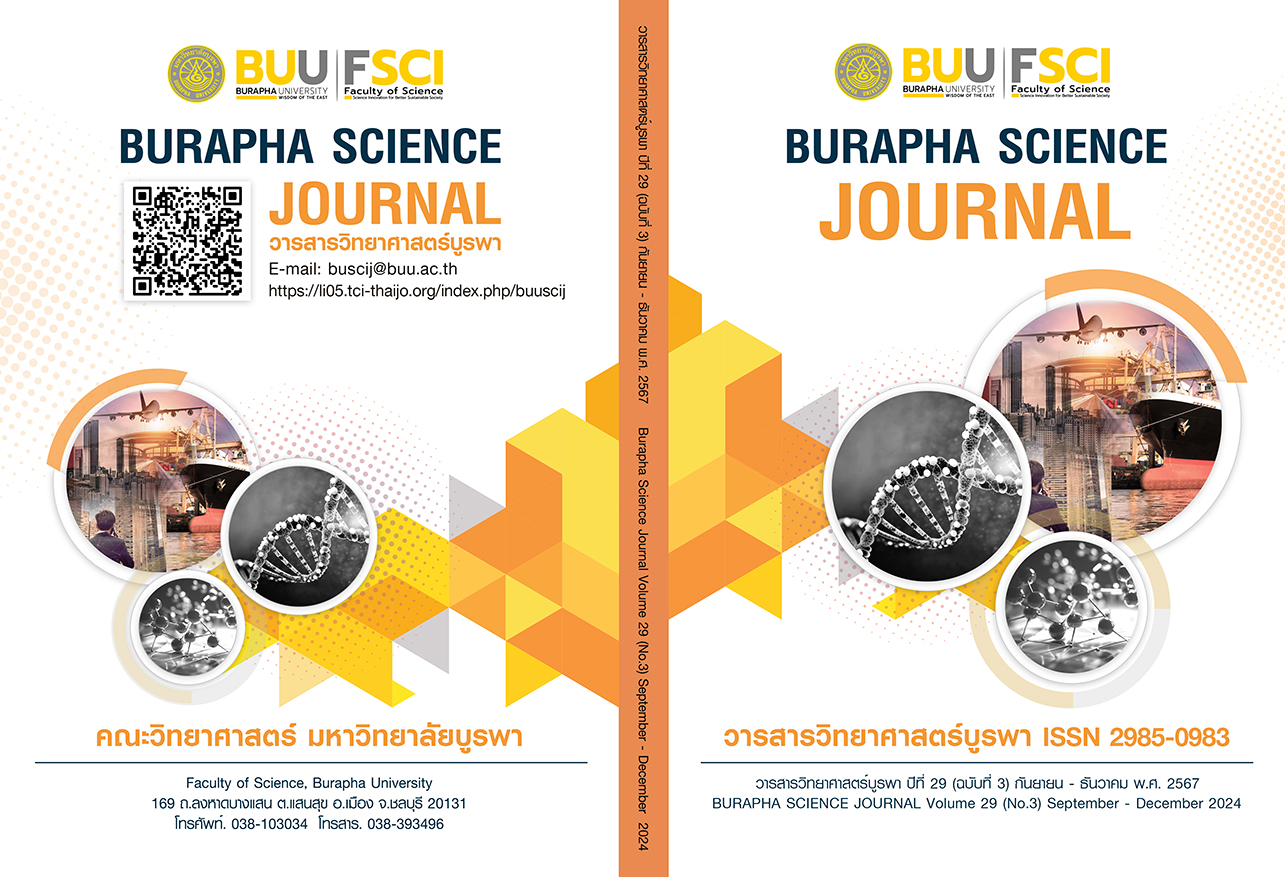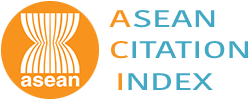การหาสภาวะที่เหมาะสมของการย่อยด้วยกรดสำหรับการวิเคราะห์โลหะ ในตัวอย่างฝุ่น PM2.5 ด้วยเทคนิค ICP-OES
คำสำคัญ:
ฝุ่นละอองขนาดเล็กกว่า 2.5 ไมครอน , การย่อยด้วยกรด , โลหะปริมาณน้อย , ความใช้ได้ของวิธีวิเคราะห์ , เทคนิคอินดักทีฟลีคัพเพิลพลาสมา ออพติคอลอิมิสชันสเปกโทรสโกปีบทคัดย่อ
วัตถุประสงค์และที่มา : ข้อจำกัดของการวิเคราะห์องค์ประกอบทางเคมีในตัวอย่างฝุ่นสำหรับการติดตามมลพิษทางอากาศ คือปริมาณตัวอย่างที่มีอย่างจำกัดและขีดจำกัดของการวิเคราะห์ในบางพารามิเตอร์ที่สำคัญ เช่น โลหะปริมาณน้อย (trace metals) ที่มีความเข้มข้นอยู่ในระดับนาโนกรัมต่อมิลลิลิตร งานวิจัยนี้มีวัตถุประสงค์เพื่อหาสภาวะที่เหมาะสมของการย่อยตัวอย่างฝุ่นด้วยกรดสำหรับการวิเคราะห์หาปริมาณโลหะปริมาณน้อยด้วยเทคนิคอินดักทีฟลีคัพเพิลพลาสมา ออพติคอลอิมิสชันสเปกโทรสโกปี (ICP-OES)
วิธีดำเนินการวิจัย : เก็บตัวอย่างฝุ่น PM2.5 ในช่วงประเพณียี่เป็ง ปี 2562 ด้วยเครื่องเก็บตัวอย่างอากาศปริมาตรสูง ที่มีอัตราการไหล 1000 ลิตรต่อนาที เป็นเวลา 24 ชั่วโมง ตัวอย่างจำนวน 7 ตัวอย่างที่มีความเข้มข้นของโลหะปริมาณน้อยแตกต่างกันถูกนำมาใช้ในการหาสภาวะที่เหมาะสมของการย่อยตัวอย่างด้วยกรดจำนวน 5 วิธี โดยศึกษาผลของปริมาณตัวอย่าง ชนิดและปริมาณของกรด วิธีการให้ความร้อน เพื่อให้ได้ประสิทธิภาพสูงสุด แล้วทำการทดสอบความใช้ได้ของวิธีวิเคราะห์หาปริมาณโลหะในตัวอย่างฝุ่น PM2.5 จำนวน 11 ชนิด ได้แก่ Ca, Mg, K, Fe, Mn, Zn, Cu, Cr, Cd, Pb และ Ni ด้วยเทคนิค ICP-OES
ผลการวิจัย : การย่อยตัวอย่างฝุ่น PM2.5 ที่ตัดเป็นวงกลมขนาดเส้นผ่านศูนย์กลาง 4.71 เซนติเมตร จำนวน 1 แผ่น ด้วยกรดผสมระหว่างกรดไฮโดรคลอริกและ กรดไนตริก ร้อยละโดยปริมาตร 16.75:5.55 ปริมาตร 20 มิลลิลิตรและให้ความร้อนด้วยเครื่องให้ความร้อนหลอดทดลอง ที่อุณหภูมิ 95 องศาเซลเซียส และปรับปริมาตรสุดท้ายเป็น 10 มิลลิลิตรก่อนนำไปตรวจวัดเป็นวิธีการย่อยที่เหมาะสมที่สุด การตรวจสอบความใช้ได้ของการวิเคราะห์หาปริมาณโลหะ จำนวน 11 ชนิด พบว่า ช่วงความเป็นเส้นตรงอยู่ระหว่าง 0.001-10 มิลลิกรัมต่อลิตร มีค่าสัมประสิทธิ์สหสัมพันธ์ (r2) อยู่ในช่วง 0.9981-0.9998 ค่าขีดจำกัดของการตรวจพบ (LOD) อยู่ในช่วง 0.015-0.154 มิลลิกรัมต่อลิตร และขีดจำกัดของการวัดเชิงปริมาณ (LOQ) อยู่ในช่วง 0.031-0.323 มิลลิกรัมต่อลิตร ค่าความแม่นแสดงด้วยค่าร้อยละของการกลับคืน (%Recovery) อยู่ในช่วงร้อยละ 80-120 ค่าความเที่ยงแสดงด้วยค่าส่วนเบี่ยงเบนมาตรฐานสัมพันธ์ (%RSD) อยู่ในช่วงร้อยละ 2-7 ยกเว้นโลหะ Ca, K, Mg และ Pb
สรุปผลการวิจัย : การหาสภาวะที่เหมาะสมของการย่อยด้วยกรด สามารถเพิ่มความสามารถในการวิเคราะห์หาปริมาณโลหะปริมาณน้อยในตัวอย่างฝุ่น PM2.5 ด้วยเทคนิค ICP-OES ได้อย่างมีประสิทธิภาพ ผลการวิเคราะห์โลหะที่ถูกต้องน่าเชื่อถือจากการตรวจสอบความใช้ได้ของวิธีเคราะห์จะเป็นประโยชน์ต่องานวิเคราะห์วิจัยทางด้านเคมีบรรยากาศสำหรับการประเมินแหล่งที่มาของฝุ่นและผลกระทบต่อสุขภาพ
เอกสารอ้างอิง
Chandra, S., Kulshrestha, M.J., Singh, R., & Singh, N. (2017). Chemical characteristics of trace metals in PM10 and their concentrated weighted trajectory analysis at Central Delhi, India. J. Environ. Sci. ,55, 184–196. https://doi.org/10.1016/j. jes.2016.06.028
Chansuebsri, S., Kolar, P., Kraisitnitikul, P., Kantarawilawan, N., Yabueng, N., Wiriya, W., Thepnuan, D., & Chantara, S. (2024). Chemical composition and origins of PM2.5 in Chiang Mai (Thailand) by integrated source apportionment and potential source areas. Atmospheric Environment, 327(March), 120517. https://doi.org/10.1016/j.atmosenv.2024.120517
Jain, S., Sharma, S.K., Mandal, T.K., & Saxena, M., (2018). Source apportionment of PM10 in Delhi, India using PCA/APCS, UNMIX and PMF. Particuology. ,37, 107–118. https://doi.org/10.1016/j.partic.2017.05.009
Kawichai, S., Bootdee, S., & Chantara, S. (2024). Health risk assessments and source apportionment of PM2.5 -bound heavy metals in the initial eastern economic corridor (EEC): A case study of. Atmospheric Pollution Research, 15(9), 102205. https://doi.org/10.1016/j.apr.2024.102205
Kraisitnitikul, P., Thepnuan, D., Chansuebsri, S., Yabueng, N., & Wiriya, W. (2024). Contrasting compositions of PM2.5 in Northern Thailand during La Niña ( 2017 ) and El Niño ( 2019 ). Journal of Environmental Sciences, 135, 585–599. https://doi.org/10.1016/j.jes.2022.09.026
Li, H., Qian, X., Hu, W., Wang, Y., & Gao, H. (2013). Chemical speciation and human health risk of trace metals in urban street dusts from a metropolitan city, Nanjing, SE China. Sci. Total Environ. ,456, 212–221. https://doi.org/10.1016/j.scitotenv.2013.03.094
Pant, P., & Harrison, R.M. (2012). Critical review of receptor modelling for particulate matter: a case study of India. Atmos. Environ. , 49, 1–12. https://doi.org/10.1016/j. atmosenv.2011.11.060
Phairuang, W., Inerb, M., Hata, M., & Furuuchi, M. (2022). Characteristics of trace elements bound to ambient nanoparticles (PM0.1) and a health risk assessment in southern Thailand. Journal of Hazardous Materials, 425, 127986. https://doi.org/10.1016/j.jhazmat.2021.127986
Pongpiachan, S., & Iijima, A. (2016). Assessment of selected metals in the ambient air PM10 in urban sites of Bangkok (Thailand). Environ. Sci. Pollut. Res. , 23 (3), 2948–2961. https://doi.org/10.1007/s11356-015-5877-5.
Qi, L., Zhang, Y., Ma, Y., Chen, M., Ge, X., Ma, Y., Zheng, J., Wang, Z., & Li, Z. (2016). Source identification of trace elements in the atmosphere during the second Asian Youth Games in Nanjing, China: influence of control measures on air quality. Atmos. Pollut. Res., 7 (3), 547–556. https://doi.org/10.1016/j.apr.2016.01.003
Saxena, M., Sharma, A., Sen, A., Saxena, P., Mandal, T.K., Sharma, S.K., & Sharma, C. (2017). Water soluble inorganic species of PM10 and PM2.5 at an urban site of Delhi, India: seasonal variability and sources. Atmos. Res., 184, 112–125. https://doi.org/10.1016/j.atmosres.2016.10.005
Thepnuan, D., & Chantara, S. (2020). Characterization of PM2.5–bound polycyclic aromatic hydrocarbons in Chiang Mai, Thailand during biomass open burning period of 2016. Applied Environmental Research, 42(3), 11–24. https://doi.org/10.35762/AER.2020.42.3.2
Thepnuan, D., Chantara, S., Lee, C. Te, Lin, N. H., & Tsai, Y. I. (2019). Molecular markers for biomass burning associated with the characterization of PM2.5 and component sources during dry season haze episodes in Upper South East Asia. Science of the Total Environment, 658, 708–722. https://doi.org/10.1016/j.scitotenv.2018.12.201
ดาวน์โหลด
เผยแพร่แล้ว
รูปแบบการอ้างอิง
ฉบับ
ประเภทบทความ
สัญญาอนุญาต
ลิขสิทธิ์ (c) 2024 คณะวิทยาศาสตร์ มหาวิทยาลัยบูรพา

อนุญาตภายใต้เงื่อนไข Creative Commons Attribution-NonCommercial-NoDerivatives 4.0 International License.
Burapha Science Journal is licensed under a Creative Commons Attribution-NonCommercial-NoDerivatives 4.0 International (CC BY-NC-ND 4.0) licence, unless otherwise stated. Please read our Policies page for more information




